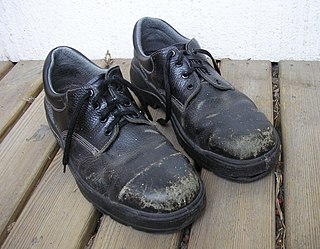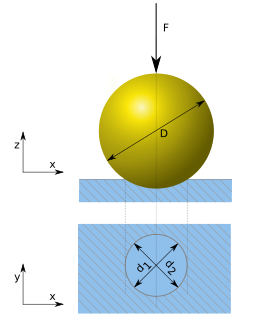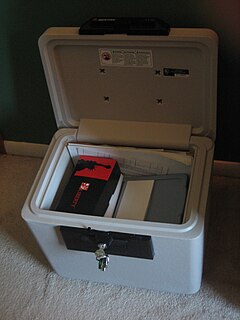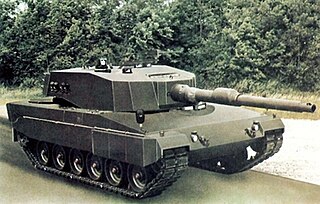This article relies largely or entirely on a single source .(March 2018) |
EN 166:2001Personal Eye-Protection - Specifications is a European standard [1] . It concerns the area of eye protection. [2] It replaced EN 166:1995.
This article relies largely or entirely on a single source .(March 2018) |
EN 166:2001Personal Eye-Protection - Specifications is a European standard [1] . It concerns the area of eye protection. [2] It replaced EN 166:1995.
| Year | Description | |
|---|---|---|
| 1995 | EN 166 (1st Edition) | |
| 2001 | EN 166 (2nd Edition) |

Personal protective equipment (PPE) is protective clothing, helmets, goggles, or other garments or equipment designed to protect the wearer's body from injury or infection. The hazards addressed by protective equipment include physical, electrical, heat, chemicals, biohazards, and airborne particulate matter. Protective equipment may be worn for job-related occupational safety and health purposes, as well as for sports and other recreational activities. "Protective clothing" is applied to traditional categories of clothing, and "protective gear" applies to items such as pads, guards, shields, or masks, and others. PPE suits can be similar in appearance to a cleanroom suit.

Sunglasses or sun glasses are a form of protective eyewear designed primarily to prevent bright sunlight and high-energy visible light from damaging or discomforting the eyes. They can sometimes also function as a visual aid, as variously termed spectacles or glasses exist, featuring lenses that are colored, polarized or darkened. In the early 20th century, they were also known as sun cheaters.

Folsom State Prison (FSP) is a California State Prison in Folsom, California, U.S., approximately 20 mi (30 km) northeast of the state capital of Sacramento. It is one of 35 adult institutions operated by the California Department of Corrections and Rehabilitation.

A steel-toe boot is a durable boot or shoe that has a protective reinforcement in the toe which protects the foot from falling objects or compression.

The Brinell scale characterizes the indentation hardness of materials through the scale of penetration of an indenter, loaded on a material test-piece. It is one of several definitions of hardness in materials science.

A safe is a secure lockable box used for securing valuable objects against theft and/or damage from fire. A safe is usually a hollow cuboid or cylinder, with one face being removable or hinged to form a door. The body and door may be cast from metal or formed out of plastic through blow molding. Bank teller safes typically are secured to the counter, have a slit opening for dropping valuables into the safe without opening it, and a time-delay combination lock to foil robbers/and or thieves. One significant distinction between types of safes is whether the safe is secured to a wall or structure or if it can be moved around. A less secure version is usually called a cash-box. A safe can be found in hotel rooms, offices and houses.

Laser safety is the safe design, use and implementation of lasers to minimize the risk of laser accidents, especially those involving eye injuries. Since even relatively small amounts of laser light can lead to permanent eye injuries, the sale and usage of lasers is typically subject to government regulations.

A respirator is a device designed to protect the wearer from inhaling hazardous atmospheres, including fumes, vapours, gases and particulate matter such as dusts and airborne microorganisms. There are two main categories: the air-purifying respirator, in which respirable air is obtained by filtering a contaminated atmosphere, and the air-supplied respirator, in which an alternate supply of breathable air is delivered. Within each category, different techniques are employed to reduce or eliminate noxious airborne contaminants.

Body armor, also known as body armour, personal armor/armour, or a suit/coat of armour, is protective clothing designed to absorb or deflect physical attacks. Historically used to protect military personnel, today it is also used by various types of police, private security guards or bodyguards, and occasionally ordinary civilians. Today there are two main types: regular non-plated body armor for moderate to substantial protection, and hard-plate reinforced body armor for maximum protection, such as used by combat soldiers.
The IP Code, or Ingress Protection Code, IEC standard 60529, sometimes interpreted as International Protection Code, classifies and rates the degree of protection provided by mechanical casings and electrical enclosures against intrusion, dust, accidental contact, and water. It is published by the International Electrotechnical Commission (IEC). The equivalent European standard is EN 60529.

A face shield, an item of personal protective equipment (PPE), aims to protect the wearer's entire face from hazards such as flying objects and road debris, chemical splashes, or potentially infectious materials.

Wood drying reduces the moisture content of wood before its use. When the drying is done in a kiln, the product is known as kiln-dried timber or lumber, whereas air drying is the more traditional method.

EN 207 is the European norm for laser safety eyewear. Any laser eye protection sold within the European Community must be certified and labeled with the CE mark. According to this standard, laser safety glasses should not only absorb laser light of a given wavelength, but they should also be able to withstand a direct hit from the laser without breaking or melting, both the filter and the frame. In this respect, the European norm is more strict than the American norm that only regulates the required optical density. More precisely, the safety glasses should be able to withstand a continuous wave laser for 5 seconds, or 50 pulses for a pulsed laser.
The European standard EN 62262 — the equivalent of international standard IEC 62262 (2002) — relates to IK ratings. This is an international numeric classification for the degrees of protection provided by enclosures for electrical equipment against external mechanical impacts. It provides a means of specifying the capacity of an enclosure to protect its contents from external impacts. The IK Code was originally defined in European Standard BS EN 50102. Following its adoption as an international standard in 2002, the European standard was renumbered EN 62262.

The Lince was a Spanish development programme for a proposed main battle tank that unfolded during the late 1980s and early 1990s. The intention was to replace the M47 and M48 Patton tanks that the Spanish Army had received under the U.S. Mutual Defense Assistance Act between 1954 and 1975, and to complement the AMX-30E tanks manufactured for the army during the 1970s. Companies from several nations, such as German Krauss-Maffei, Spanish Santa Bárbara, and French GIAT, made bids for the development contract. The main priorities were mobility and firepower, with secondary priority placed on protection; the Lince tank was to have been lighter and faster than its competitors. The vehicle's size would also have been restricted by the Spanish rail and highway network. To achieve a sufficient level of firepower and protection, given the size requirements, the Lince was to use Rheinmetall's 120 mm L/44 tank-gun and German composite armour from the Leopard 2A4.
Ballistic eyewear is a form of glasses or goggles that protect from small projectiles and fragments. For the U.S. military, choices are listed on the Authorized Protective Eyewear List (APEL). Ballistic eyewear including examples that meet APEL requirements are commercially available for anyone who wishes to buy it. The history of protective eyewear goes back to 1880 and extends through to World War I and the present. There are three standards that are currently used to test the effectiveness of ballistic eyewear. These include a U.S. civilian standard, a U.S. military standard (MIL-PRF-31013), and a European standard.

The Combined Charging System (CCS) covers charging electric vehicles using the Combo 1 and Combo 2 connectors at up to 350 kilowatts. These two connectors are extensions of the Type 1 and Type 2 connectors, with two additional direct current (DC) contacts to allow high-power DC fast charging.
ISO 7010 is an International Organization for Standardization technical standard for graphical hazard symbols on hazard and safety signs, including those indicating emergency exits. It uses colours and principles set out in ISO 3864 for these symbols, and is intended to provide "safety information that relies as little as possible on the use of words to achieve understanding." It is distinct from the Globally Harmonized System of Classification and Labelling of Chemicals specified by the United Nations to standardise hazardous material classification and labelling.

Medical gowns are hospital gowns worn by medical professionals as personal protective equipment (PPE) in order to provide a barrier between patient and professional. Whereas patient gowns are flimsy often with exposed backs and arms, PPE gowns as seen below in the cardiac surgeon photograph cover most of the exposed skin surfaces of the professional medics.
| This standards- or measurement-related article is a stub. You can help Wikipedia by expanding it. |